Blog Archives
September 14, 2003 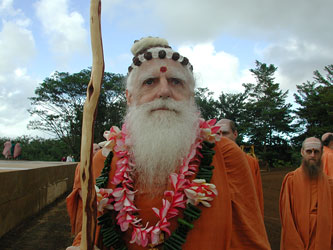
Gurudeva parading round the foundation of Iraivan, 2001.
Our Beloved and Revered Satguru Sivaya Subramuniyaswami
Attained Maha Samadhi on November 12th, 2001
Click to read for Details.
We are pleased to announce the web release of Satguru Sivaya Subramuniyaswami's monumental work on Hindu culture and lifestyle:
Living with Siva.
Click here for the entire text and artwork, now on-line!
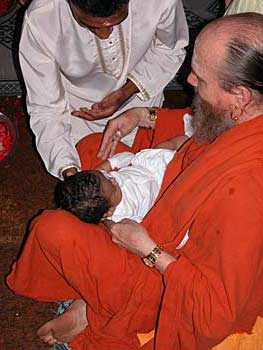
Bodhinatha blesses Easan Saravan in Singapore, more below.
Bodhinatha's Sun One Video. Most Recent update: September 12, 2003. Bodhinatha speaks on Ahimsa, noninjury, yama #1, which is noninjury in thought, word and deed. The law of karma decrees that it is wise not to harm or hurt others, for we will then receive harm and hurt in exchange in the future. 12 minutes, 29 seconds.
 |
|
|
|
Live Web Cam Pix! |
 |
||||
We continue the story of Bodhinatha's mission with three more photo segments, this time from the city of Singapore, which has long been a hub of activity and transit for our Satgurus and monks. The dedicated group of sishya and devotees there never fail to provide a great support team. And the small Hindu community is one of the strongest. Here we are at the home of Kulapati Dohadeva Samugam for the padapuja and talk by Bodhinatha to the close sishya and devotees.
Girish Samugam on right, assisting his father Dohadeva with the puja.
Master Course student Mrs. Rema Devi Karthigesu.
Arati to Bodhinatha....
Here is Anusha, daughter of the family.
Everyone comes forward for vibhuti.
Sister of Shanta Devi Periasamy, with her husband being presented a shawl on the occasion of her husband's 60th birthday
Samugam family shrine, in a separate room of the house
Next set of photos are all taken at Sri Sivan Temple on the occasion of the namakarana samskara for little Easan Saravan, son of Sivakumar and Lavanya. Below, Sivakumar bathes Bodhinatha's feet below the entrance steps of the temple.
As with many Hindu temples in Singapore, this one is beautifully appointed and maintained. Hundi, kodimaram and central Sivalingam shrine in background. With a Sivalingam in this temple it is especially important for us as a Saivite temple.
Father Sivakumar and mother Lavanya participate in the sankalpa.... priest has a beautiful voice as he performs the samskara and his voice is amplified through a loudspeaker, resounding off the temple walls.
Little Easan awaits to receive is name in the lap of another devotee.
The main priest did the chanting, while he is training a younger priest to perform the physical mudras and such.
The temple is a circular structure, with no side walls, just pillars holding up the roof
Expert musicians playing for the samskara.... Tavil
... and nadasvaram.
Lavanya holds her first-born while Sivakumar continues with the kriyas.
The tray of rice is blessed by the father with flower petals.
Bodhinatha writes Easan's name in the rice.
Then he holds Easan below and whispers the name into his ear.
Sivakumar now holds his newly named boy. Welcome to the Hindu family, little Easan Saravan!
Looking around the temple we find this poster describing Hinduism
These photos are taken from outside the temple, down on the floor below the entrance steps.
It is all cement, but so exquisitely crafted.
Concrete jalakams, (windows) gives a sense of what our granite jalakams will look like on Iraivan.
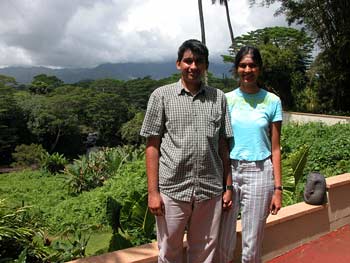
Back home at the Aadheenam we had a guest couple today from California.
 The Remarkable Vision |
Iraivan Temple Progress Update |
Join this historic undertaking. Please contribute generously. Sponsor a stone today! |
| Order Rudraksha Malas from Siva's sacred Hawaiian groves; and also single rudraksha beads ready to put on a chain around your neck. Great for Gifts! All proceeds go to the building fund. | ||
|
Current Overview  |
||

A look inside the Iraivan temple model....
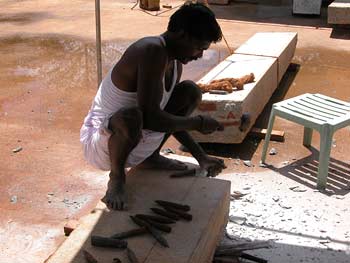
Our new silpis at work.
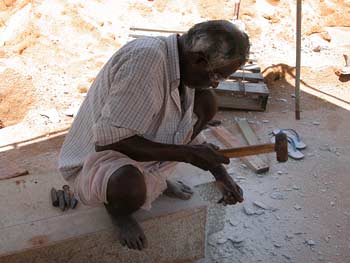
This new crew are really speedy and precise in carving.
![]()
Saiva Siddhanta Church
California, USA
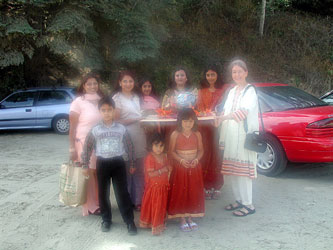
Kulapati Janaka Param and his wife Kulamata Bhavani live in Northern California, by the sea. They held their own little Ganesha Visarjana last week with a few Hindu in the area and send these photos....Janaka writes:
"Here are a few photos of our Monday, September 8th Visarjana and Mendocino, Big River Beach. We heard there were some Hindus in the area, called them up and met them for the first time at the "parade" departure point by the beach.
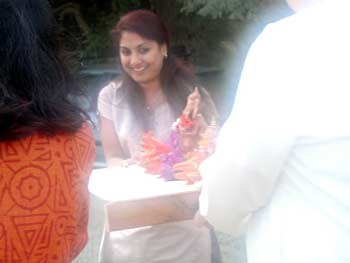
We seem to have a little moisture on our lens or perhaps this is the divine glow of bhakti shining from these devotees on this auspicious day!
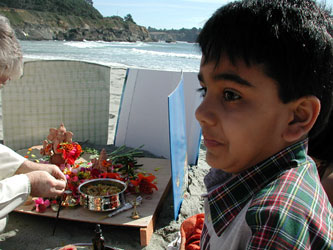
Our procession, accompanied by Bhavani leading Ganesha bhajans, was for about a half mile.
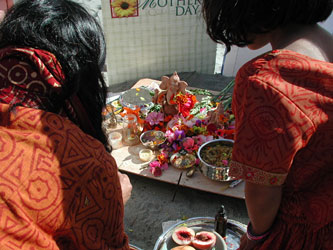
Then wading over to a large sand bar where we walked out to the ocean.
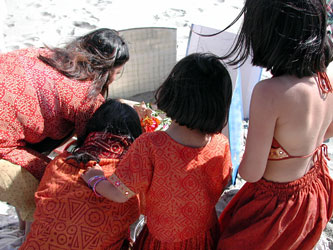
Everyone makes there offerings.
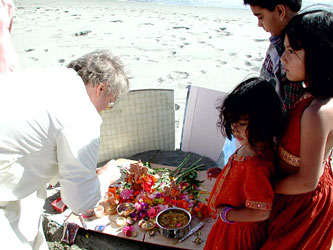
Then, Ganesha puja.
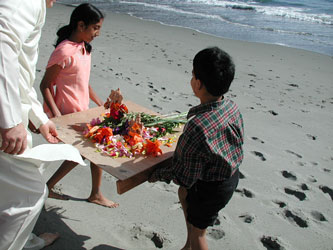
Now the children take Ganesha to the edge of the water.
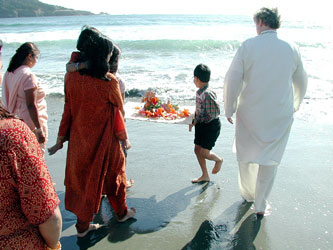
"Oh, the waves are coming!"

Kulapati Janaka goes into the ocean with the wooden tray full of Ganeshas.

Goodbye Ganesha! Such a beautiful and auspicious moment as the murthis merge back into the Cosmic Ocean.
No Audio Today
|
Be surprised! Take this opportunity for an adventure. Close your eyes and click to get a message picked at random from the vast audio archives of our Satgurus' discourses |
And click here for an Index to All Past CyberTalks.
|
| FULL INDEX OF 650+ CYBERTALKS
 |
|
Study Gurudeva's teachings.
|
transcription begins
Date: August_10_2003
Title: The Niyama of Mati, Cognition
Category: Yamas and Niyamas
Duration: 11 min., 39 seconds
Date Given: July 15, 2003
Given by: Bodhinatha
Good morning, everyone!
Continuing with the series on the talks on 'Yamas and NIyamas', Hinduism's Code of Conduct, the twenty principles, which govern spiritual life so nicely. The Yamas, of course, are the restraints, harnessing the instinctive mind and the Niyamas are the observances where we are expressing our soul qualities. So today, we are up to Niyama 7. As we mentioned the last Sun One, the last 5 niyamas, 6-10, as expounded by Gurudeva, all relate in someway to the Guru. We will see that as one of the themes this morning - how Cognition relates to the Guru.
Today's lesson on 'Good Conduct' is on the seventh Niyama of Mati, which is to develop a spiritual will and intellect with your satguru's guidance. Strive for knowledge of God, to awaken the light within. Discover the hidden lesson in each experience to develop a profound understanding of life and yourself. Through meditation, cultivate intuition by listening to the still, small voice within, by understanding the subtle sciences, inner worlds and mystical texts.
Let us look at some examples, illustrating the practice of this Niyama.
First example: In studying about karma and karmic cycles, a young woman intuitively saw how the same karmic cycle involving an accident had repeated itself three times in her life so far.
Second example: A man who had developed a strong intellectual pride from his university training began studying with a swami. After studying for about five years with the swami, the young man's nature had changed into a more humble one that recognized the limitations of his intellectual knowledge when compared to intuitive knowledge.
Third example: A young woman decided to attend the 5 AM Ganesha Puja at a nearby temple for each of the twenty-one days of Vinayaga Viratam and successfully did so without missing one day.
Fourth example: After attending a particularly powerful Ganesha puja, a young man had an intuitive insight that the best career for him to pursue to fulfill his swadharma in the highest way is that of a teacher.
All of the Niyamas focus on expressing the refined soul qualities within each of us. In the case of Mati, the divine quality we are expressing is becoming a more spiritual person through developing a spiritual intellect, utilizing our willpower to achieve inner, spiritual goals and tapping into our intuition to provide answers from our superconscious mind.
The Tirukural in its Chapter 36, 'Knowledge of Truth', in Verse 352 stresses the importance of intuition when it talks about the power of "undimmed perception." Also, it beautifully echos the thought in our description of Mati, to strive for knowledge of God to awaken the light within. The Kural verse reads:
"For those of undimmed perception, free from delusion, darkness departs and rapture rushes in."
The first aspect of practicing Mati is developing a spiritual intellect. The intellect is the thinking portion of our mind. It goes through a developmental process over a period of many lives. At first, the thinking mind is dominated by our instinctive nature. We are caught up in the lower emotions of fear, anger, jealousy and revenge. Also, the negative karmas caused by our adharmic deeds keep the intellect in a constant state of disturbance.
Over time, we gain greater and greater control over these emotions as well as, discipline ourselves to follow a dharmic life by observing the yamas. At that point, our mind is calm from the positive karmas caused by our dharmic deeds and the lower emotions no longer dominate our intellect. They are replaced by the faculties of memory and reason.
Memory and reason are useful but limited as they cannot provide the answers to the deeper questions in life. In fact, if they are over-stimulated, they can keep the thinking mind quite active and somewhat frustrated. Unfortunately, modern secular education teaches us to rely totally on memory and reason and encourages us to think that our intellectual abilities are who we are. Therefore, especially important to developing a spiritualized intellect is the Niyama of Siddhanta Sravana, study of the teachings and listening to the wise, as it fills the intellect with right, religious knowledge which eventually brings humility as well.
We spiritualize our intellect further by looking for knowledge in the superconscious realms beyond the realms of memory and reason. We can draw a comparison to worship. Our attitude in worship is to seek the blessings of God and Gods who are far more developed spiritually and far wiser than we. Our attitude in seeking knowledge from our intuition should be the same, that our faculty of intuition is far wiser than our faculties of memory and reason and that we seek knowledge from our superconscious intuition that cannot be attained through mere memory and reason. However, such knowledge can be used by memory and reason once it is received.
A second aspect of practicing Mati is developing a spiritual will. Willpower is the strength of will to carry out one's decisions, wishes or plans. People who regularly make plans and fail to carry them out lack willpower. For example, a student often plans to get up early to study for his tests but always when the time comes decides to continue sleeping instead. Willpower is channeling the rarefied energies of the body, of awareness itself, into attention and concentration upon everything that we do through the day. How can this be cultivated?
Gurudeva gives us the key in 'Merging with Siva'.
"Willpower can be cultivated by finishing and doing well every task that we undertake. In fact, done a little better than our expectations." First finish each task. Second do it well. "Nothing is done with half our mind thinking about something else. Nothing is dropped in the middle. Developing these two important habits produces an indomitable willpower."
Gurudeva has an insightful comment on willpower: "The more you use your personal, individual willpower, the more willpower you have."
Once we have an indomitable willpower, how then can we spiritualize it? We spiritualize it by living a spiritual life. This means controlling our instinctive impulses through following well, the yamas. It means striving to perfect the niyamas especially contentment, austerity, giving, faith and regular worship. It means holding the humble attitude that our intellectual knowledge produced through memory and reason is quite limited and pales before the knowledge that comes from our superconscious. It means engaging in regular worship and meditation in which we strive to personally experience the divine realms of the Gods and of our soul.
A third aspect of Mati is to cultivate intuition. So far, we have acquired a body of spiritual knowledge through reading and listening that is based on the experiences, insights and observations of others. The idea now is to add to this knowledge through our own insights, observations and experiences and thereby, further deepen our understanding.
Intuition is direct understanding or cognition which comes from our superconscious mind which bypasses the process of reason. Intuition is a far superior source of knowing than reason but it does not contradict reason.
Here is a story to illustrate intuition. A husband and wife normally don't argue. However, an exception is that they do regularly argue about money at the time the husband gets his monthly paycheck. The husband never gave the matter much thought until on one such occasion, he has an insight that his parents did the same thing. He then concludes that he has picked up this habit from them and decides to break the habit, which with the support of his intuitive insight he is successful at.
If prior to the insight we had asked this man why he argued regularly at the time he was paid, he would not have been able to answer the question through his faculties of memory and reason. It took the new knowledge added by his intuitive insight to provide the answer.
Part of the challenge in cultivating intuition is to distinguish a thought that comes from intuition from one that comes from memory and reason. A simple way of doing so is to know that insights are a flash of understanding that contain a complete concept and are short in duration. Thoughts from memory and reason are partial concepts and last a longer time.
Also effective in catalyzing the process of having intuitive insights is the worship of Lord Ganesha. His Darshan helps us move into the intuitive area of the mind.
For the full development of Mati, Gurudeva states that, "It requires the grace of the satguru as it is a transference of divine energies from the satguru to the sishya, building a purified intellect honed down by the guru for the sishya, and a spiritual will developed by the sishya by following the religious sadhanas the guru has laid down until the desired results are attained to the guru's satisfaction."
In conclusion, develop a spiritual will and intellect with your satguru's guidance. Strive for knowledge of God, to awaken the light within. Discover the hidden lesson in each experience to develop a profound understanding of life and yourself. Through meditation, cultivate intuition by listening to the still, small voice within, by understanding the subtle sciences, inner worlds and mystical texts.
Aum Namah Sivaya!
transcription ends
|
MORE UPLIFTING THINGS |
2004 Indian Odyssey
Join Satguru Bodhinatha Veylanswami on an 18 day Innersearch to South India, from Jan 19 to Feb 5, as we pilgrimage to ancient monasteries, magnificent 1,000 plus year old sacred temples and meet with India's holy men in a life-transforming adventure. Click on the above link for more details. |
|

|
Check our children and youth section for new items for the young and young at heart! | |
|
1. SIGN OUR GUESTBOOK and receive a FREE GIFT |
||
| 2. Newest Book: LIVING WITH SIVA | ||
|
3. Visiting KAUAI'S HINDU MONASTERY |
||
|
4. Contribute to THANK YOU, GURUDEVA FUND |
||